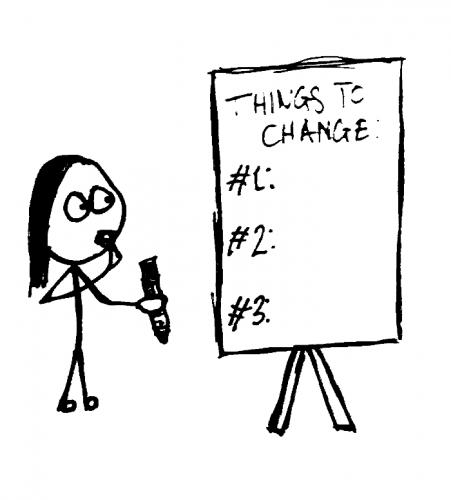OK. So you’ve just done your amazing presentation and you completely killed it.
That’s a good thing – English idioms are strange. Your presentation was a complete success!
So now you can go and sit in the hotel hot tub, eat carrot cake and watch Clint Eastwood movies, right?
Wrong! There’s still a bit of work to do.
But after that you can hit the hot tub. I promise.
“But what is there to do? The presentation’s over!” I can hear you say.
Good question.
Now you need to tear the presentation you’ve just done into pieces. You need to figure out what worked and what didn’t work.
You need to perform a post mortem – in six simple steps …
1. Talk to people and get feedback make contacts and email addresses

So it’s quite tempting to just run out of the room as soon as the presentation’s over and head straight to the buffet with the nice finger food they often have at conferences.
But it can wait!
Hang around for a bit. Let people come up to you and talk to you.
Hopefully there will be a few people who have some questions or who’d just like to chat with you.
This is a great opportunity for a number of reasons:
- You can get an impression of how well the presentation went depending on how the person you’re talking to you behaves. Are they open and enthusiastic? Or are they a little formal and distant?
- There’s a chance you’ll get another opportunity to do the same presentation. If your presentation went well, you might be asked to do it again somewhere else. Perhaps with all expenses paid. Including the mini bar. And a massage. Who knows?
- It’s a great opportunity to make new contacts. If someone wants to talk to you after your presentation, it’s probably a good thing. They probably liked it. Get their business card or email address. You can use it later (more on that in step three). Also, make sure you hang around at the conference, or symposium or wherever it is you’re giving your presentation. Keep yourself as visible as possible. This is another good opportunity to get some more relaxed feedback. Especially if there have been some drinks involved.
2. Find some time and space and write all your immediate impressions

OK. So you’ve had a productive chat with one or two people.
You got a couple of business cards as well as an impression of how well the presentation went.
But now it’s time to go into your own head!
Find a quiet corner somewhere and sit down with your laptop (or pen and paper) and just let all your feelings flow out onto the keyboard (or paper).
Well – not ALL your feelings. You don’t need to write about how angry that Leanardo Dicaprio film made you. Or how much you love early 20thcentury avant garde classical musical composers.
Your feelings about the presentation of course.
Ask yourself the key questions:
- Did I get my point across?
- Was it effective?
- Was anything confusing?
- Did anyone seem lost?
- Did any of the jokes fall flat (not work)?
- How do I feel about it?
But also write down absolutely ANYTHING else you feel about it.
The more random and chaotic your document (or piece of paper) looks at the end, the better.
Don’t worry if it’s messy and disorganised; you’ll be coming back to this later.
Then hit the buffet!
3. Get follow ups – email people and go on social media

OK. It’s later on in the day, or perhaps even the next day.
And it’s time to make use of the email addresses and business cards you (hopefully) picked up earlier.
It’s time to ask for some feedback.
Make a list of any email addresses you took off people who saw your presentation. If there were some friends or colleagues at the presentation, add them to the list.
The trick here is to make sure each email is personalised and informal.
Also don’t fall into the trap of asking “How was it?”
Whenever you ask anyone that question, the answer is (almost) always “It was great!” whether it was awesome or terrible.
Even if it was great, this isn’t the answer you want – you need something more useful.
So instead of just asking how it was, try asking for some “constructive criticism” or a “critique.”
Remember: you want to find out what needs improving, not just enjoy random praise. Words like “criticism” encourage people to do that.
Also, if you were speaking at a large conference, have a look on social media and see if anyone’s talking about your presentation. This feedback will be more objective (and therefore more useful).
But don’t stop there! If people are talking about it on social media, join in the conversation. See if you can find out more!
Finally, get back to the organisers and thank them for the opportunity. This will increase your chances of being invited back.
4. After a few days, get those notes and consolidate them

Now it’s time to just relax and leave everything for a couple of days.
Put some space between you and the presentation.
Then, a few days afterwards, get out those chaotic notes from step two.
It’ll be strange seeing your own stream of consciousness in front of you.
But the cool thing about this stage is that your brain will demand you to organise your notes! And that’s good news, because that’s exactly what you need to do at this stage.
Look through the notes and try to find four or five main points from them.
Perhaps a particular joke didn’t go well, so your bullet point can read “Don’t do the joke about llamas again.”
Or perhaps you were aware of people losing track at a certain point.
In which case your bullet point can read “turn the point about sales fluctuation into a metaphor.”
5. Check the video!

OK. It’s time for the painful experience of watching yourself and noticing all the awful little details that only you will notice but that no one else really cares about.
Things like the fact that your shirt isn’t properly tucked in at the back.
Or that weird thing you do with your eyes when you get excited.
But don’t worry about those things. It’s time to analyse the core of the presentation.
For this step, you’re going to need to watch the footage three times, but each time you’re going to focus on something different.
- First viewing:
Watch the footage and just take in the overall impression (ignoring that weird eye thing).
Pick up on things like the main goals, the audience reaction or whether that llama joke went well.
Also make a mental note of anything that stood out.
Perhaps there was a slide that confused everyone.
Or perhaps a particular point had everyone hanging onto your every word.
- After the first viewing:
Compare your overall impression with the five or six bullet points you made in step four.
The combination of your impressions from your notes and your impressions from the video will give you a stronger, more objective view of how the presentation went – both the good things and the bad things.
- Second viewing:
Focus on the audio.
Did you project your voice well?
Did you ramble (talking off script and too much about a single topic even though everyone already got your point 10 sentences ago)?
Did you vary the tone and the volume of your voice to keep it sounding interesting?
Did you pause well?
Make a mental note of the things that need improving.
- Third viewing
Focus on the more visual aspects of the talk. If it helps, you can turn off the audio for this one.
Pay attention to things like your body language; did you move about on stage purposefully or was it nervous pacing?
Did you use your hands in a way that made the point stronger or in a way that was kind of distracting?
Look at the audience. Are they interested? Or do they look like they’re wondering whether they left the oven on?
Are you making eye contact with the audience? Or are you looking down at your feet?
Once you’ve got through these three viewings, you’re ready for the final step …
6. Make a list of no more than 3 things to change

OK. So you’ve got feedback from people who were there.
You’ve taken your impressions and feelings and cross-referenced them with your feelings of watching yourself.
Now it’s time to reflect.
Walk away from the laptop! Go and make a cup of green tea or look out of the window.
Maybe even go for a walk or a cycle (I get some of my best ideas and revelations while cycling).
While doing this, consider three things to change about your performance.
You might want to make a huge list of all the little details that could be improved.
But for now, just focus on three.
And don’t write it down; if you can’t keep them in your head, they won’t be useful.
Three’s a good number – it stops you from getting overwhelmed and is completely manageable.
Even if there are more changes you’d like to make, there’s a chance you’ll subconsciously make those changes anyway – so focus on the big three for now.
That’s it!
Now you’re ready for the next presentation.
Here’s the whole process in one timeline:

Each time you do this, your performance will keep improving and you will soon be known as the Talk Master! Or even The Talk Master General!
Did you enjoy reading this article? Here’s more advice on effective public speaking.
Making Public Speaking Easy #1: Preparation
Making Public Speaking Easy #2: The Big Day
Gabriel Clark, LOS Consultant & Clark and Miller Co-founder
